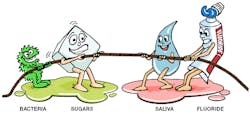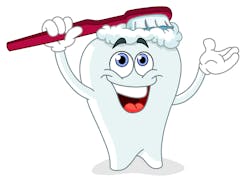Deciduous teeth myths, and the effects of parents on childhood oral hygiene
It is popularly believed that because deciduous teeth will be replaced, they do not need care. Some researchers are looking to discover new methods to change these misunderstandings.
Changing perceptions
Case Western Reserve University School of Dental Medicine in Cleveland and the University of Washington Northwest Center to Reduce Oral Health Disparities in Seattle researchers plan to activate a behavioral intervention to alter the way parents and caregivers view deciduous teeth and the need to keep them healthy and free of decay. The effort is supported by a $1.6-million, 2.5-year study, "Family Intervention with Caregivers of Children with Dental Needs," funded by National Institute of Dental and Craniofacial Research. (1) The goal of the study is to create new ways to dispel the myths that exist about “baby” teeth, and in the end to increase the level of oral care for children. The investigators will create a referral letter and educational materials for parents and caregivers, and determine if those resources motivate those recruited for the study to keep their children's teeth healthy. (1)
There are numerous ways to improve the oral health of children, and educating parents and caregivers is one of them. According to a policy statement from the American Academy of Pediatrics (AAP) published online in November 1014 in Pediatrics, another way is for pediatricians to be more involved with the oral health of young children. (2)
Recommendations for pediatrician involvement are:
- Occasionally performing an oral health risk assessment for all children
- Including anticipatory guidance for oral health as part of comprehensive patient counseling
- Advising parents and caregivers to decrease ingestion of sugar in foods and drinks
- Encouraging tooth brushing when the primary teeth erupt
- Advising parents and caregivers to guide tooth brushing until age 8
- Building cooperative relationships with local dentists. (2)
The policy statement discusses the role of various types of fluoride, anticipatory guidance, dietary counseling, among other topics. The statement, in conjunction with the oral health recommendations of the third edition of the AAP’s “Bright Futures: Guidelines for Health Supervision of Infants, Children, and Adolescents,” is a resource for pediatricians and other pediatric primary care providers regarding oral health. (3)
In other news, a study was conducted to determine if there is an association between the type of dental procedure being performed on children and parents’ wishes to accompany children in the operatory. (4) A survey including scenarios, descriptions, and illustrations of procedures was sent to parents. Most of the parents were between 25 and 40 years of age, and had attended high school. Nearly three quarters of respondents were females (73%) and 60% were of Hispanic origin. (4) 78% of the responding parents reported that they wanted to be present during their child’s dental treatment, as the child would be more comfortable. (4)
Parenting styles have an effect on how parents and children act in a dental office. A recent study assessed the association between parenting style, sociodemographic data, caries status, and child's behavior during the first dental visit. (5) Parents completed the Parenting Styles and Dimensions Questionnaire (PSDQ). The PSDQ evaluates parenting style based on Diana Baumrind’s parenting types: authoritative, authoritarian, and permissive. Diana Blumberg Baumrind is a clinical and developmental psychologist known for her research on parenting styles. The Frankl scale was used to place children’s behavior into four categories: definitely negative, negative, positive and definitely positive, from which children’s behaviors were ultimately categorized as negative or positive. (5) It seems indicates that authoritative parents have the most reliably positive impact on children, and daycare attendance was related to better behavior. (5, 6)
Toothbrushing habits
Toothbrushing is an important aspect of oral hygiene regimes. A study published in Caries Research assessed the association between parental and familial influences and children's toothbrushing frequency during the day. (7) Creation of habits is an important feature in regular toothbrushing frequency. Also, a more established daily routine was significantly associated with better morning and evening brushing habits. (7) Morning brushing was more frequent than evening brushing. It is important to recognize parental influence differences as we create interventions to improve childhood brushing frequency.
And lastly, Early Childhood Caries (ECC) has been in the news again. We know that dental decay disproportionally occurs in low-income children. While the condition is preventable, much of the funding provided by Medicaid is for treatment of ECC. In a system-model analysis, investigators compared possible outcomes of nine preventive interventions: water fluoridation, fluoride varnish, fluoride toothpaste, medical screening and fluoride varnish application, bacterial transmission reduction, motivational interviewing, dental prevention visits, secondary prevention, and combinations. (8) 10-year disease reductions and savings from water fluoridation, motivational interviewing, and fluoride toothpaste are projected. In conclusion, the authors state that interventions requiring health professionals cost more than they save. Interventions that target high-risk children, begin early, and combine numerous approaches have the greatest potential to reduce ECC-related and Medicaid expenditures.
References
1. Contrary to popular belief, dental care for baby teeth is vital. Medical Xpress. http://medicalxpress.com/news/2015-01-contrary-popular-belief-dental-baby.html. Published January 22, 2015. Accessed May 12, 2015.
2. American Academy of Pediatrics. Maintaining and improving the oral health of young children. Pediatrics. 2014;134:1224-9. doi: 10.1542. http://pediatrics.aappublications.org/content/134/6/1224.full.pdf+html.
3. American Academy of Pediatrics. Promoting oral health intervention for pediatricians. Pediatrics. 2008;122:1387-94. doi: 10.1542. http://pediatrics.aappublications.org/content/122/6/1387.full.
4. Shroff S, Hughes C, Mobley C. Attitudes and preferences of parents about being present in the dental operatory. Pediatr Dent. 2015;37:51-5.
5. Howenstein J, Kumar A, Casamassimo PS, McTigue D, Coury D, Yin H. Correlating parenting styles with child behavior and caries. Pediatr Dent. 2015;37:59-64.
6. Baumrind, D. Child care practices anteceding three patterns of preschool behavior. Genet Psychol Monogr. 1967;75:43-88.
7. Trubey RJ, Moore SC, Chestnutt IG. Children's toothbrushing frequency: The influence of parents' rationale for brushing, habits and family routines. Caries Res. 2015;49:157-164.
8. Edelstein BL, Hirsch G, Frosh M, Kumar J. Reducing early childhood caries in a Medicaid population: A systems model analysis. J Am Dent Assoc. 2015;146:224-232.









